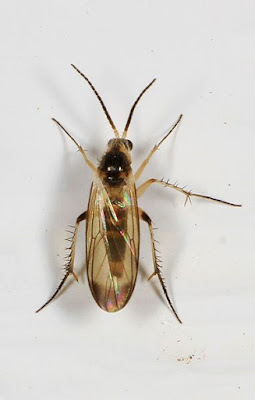In suburbia we do a lot to protect our homes. We cut down tall trees before they can fall on them. We put in lights along the front walk, the garage and the front door to deter (or blind) any potential burglar and increase curb appeal in case we want to sell them. We put up fences to keep children and pets in and strangers out. We mow our lawns within an inch of their lives and then use our leaf blowers to get every last speck of substance off our property and into the street, where it miraculously disappears.
 |
| Lethal method 1: yellow sticky strips in the house plants (Margo D. Beller) |
Inside we clean germs - real or imagined - from surfaces. And if we see insects, we want them out ASAP.
That can be a tall task because there are a lot of insects.
According to my copy of the "Kaufman Field Guide to Insects of North America," there are over 24,000 types of beetles in 113 families in North America north of Mexico alone, so Haldane knew what he was talking about. They include leaf-cutters, ground beetles, ladybugs, dung beetles, scarabs, water beetles and long-horned beetles, among many others.
There are other insects including wood borers, wasps, bees, butterflies and moths. Some insects are beneficial, such as aphid-eating ladybugs and pollenator bees and butterflies. Some are bird food, such as the carpenter ants favored by pileated woodpeckers.
And then there are the flies. Kaufman says there are 17,000 types on this continent, and they include pesky gnats, mosquitos and maggots.
 |
| Lethal method 2: extension dust mop (Margo D. Beller) |
There are companies that make their living killing rodents, spiders and insects. There are also a lot of products homeowners can use to kill mice, spiders, flies, cockroaches and other space invaders, including ways that won't make you sick using them.
Two years ago, during a drought, we were faced with an invasion of carpenter ants that had somehow gotten into one of our bathrooms. To get rid of them my husband (MH) went to a big box store and bought traps that contained poisoned sugar water. The hungry/thirsty soldier ants took the bait back to the queen and fed her. She died. Soon the colony started dying. Problem solved.
This year we have had lots of rain but we've also had another type of bathroom invader - drain flies. I would find what looked like a small fly hopping around the sink or on the wall. MH looked them up and we learned about drain flies, which, despite the name, are in the flea family and feed on organic matter in sink drains. (Organic matter? In my sink?)
Getting rid of them was as easy as using drain cleaner followed by pouring in a pot of boiling water. Problem solved.
But when it comes to insects the battle is never really over, it just moves elsewhere and with a different combatant. Currently, it is on the enclosed porch against fungas gnats.
 |
| "Fungus Gnat - Rondaniella dimidiata, Woodbridge, Virginia" by Judy Gallagher is licensed under CC BY 2.0. |
I'd be having my morning coffee on the porch and something would flutter by. It would land on a surface and I'd catch it in a container and put it outside. Soon I started to see more of them, which is when MH again looked it up and I learned the name of this invader. (I'm guessing eggs had been laid in a plant I had outside and then moved to the porch.) I've since learned watering my plants has made the problem worse because wet soil helps them breed.
So I've stopped my catch-and-release policy and and have taken to elimination with extreme prejudice.
To my shame I first considered the flying insect spray we had in the garage, but that might (or might not, depending on the website article I read) harm the plants (and me). Then I went to the big box store and bought some yellow sticky strips to put on posts placed just above the soil in the pots to catch any adults. I'm letting the plants dry out and will then soak the soil with hydrogen peroxide to kill any eggs or larvae. I've also put out vinegar traps.
I hope all this works because winter will be here soon enough and the plants will have to go back inside. But so far I have found no dead gnats and the live ones are still flying around on the porch.

My friend the spider caught at least three gnats. I'm hoping it gets more.
(Margo D. Beller)
So now I've gotten back to basics: smashing them with an extension dust mop. It gives me reach, exercise and the illusion I am doing something about the problem.
I've also discovered I have an ally - spiders. Yes, those same critters others want to kill and get out of the house are spinning webs on the porch and catching some gnats. According to Kaufman there are 4,000 types of spiders in North America and I have found many of their webs in the house, on the lawn, in the trees and in various areas of the porch.
I am not crazy about spiders in the house because their webs show me where I have been lax and really need to clean. But they are catching insects, and on the porch spiders are more than welcome to spin their webs and gather as many gnats or anything else as they want.

